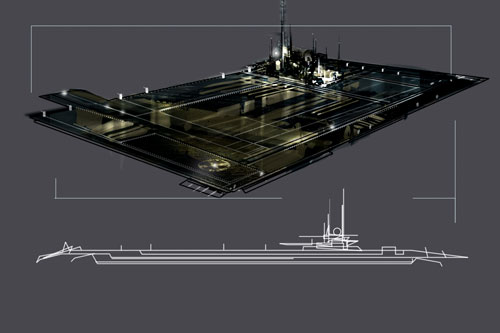Space-Centric Warfare, Part Four: Naval Combat
(For Part One of this essay, click HERE.)
All of the attention upon space left the leaders of the non-space services scrambling to assert the significance of their own theaters (though they hedged their bets by building up their own space-based presences). They experienced mixed success in this regard. Perhaps the fiercest such debate centered on the role that the sea would play. Unsurprisingly, the navies of both sides argued that Neptune’s arena would be a crucial one, and they mounted a wide range of arguments to support their claim.
The experience of the U.S. Navy in developing and making its case is particularly instructive. Its officers contended that since all the nations across the three Eastern continents were either neutral or Eurasian vassals, attacks launched from the oceans were the most immediate route, save from space itself, to deploy U.S. munitions without warning into the East’s defenses. Indeed, at the core of the Navy’s calculations was an attempt to replicate a key component of its strategy during the First Cold War: namely, encircling Russia and China with a series of bases capable of projecting force into their homelands.
The question, though, was the nature of that force. The dominant naval platform of the 20th century, the aircraft carrier, had become obsolete long before the full resurgence of the Eurasian powers. Carriers were simply too vulnerable to waves of torpedoes and ever-faster cruise missiles. An increasing proportion of the force in any one carrier group had to be dedicated solely to protecting the carrier—yet such precautions failed (in spectacular fashion) against more than one “rogue state” in the first two decades of the 21st century.
The solution to all this was as radical as it was expensive: since a maneuvering boat was essentially motionless relative to onrushing hypersonic missiles, why bother trying to build any evasive capability into a capital ship at all? Why not make it motionless? Thus was conceived the Raft (also called the Floating Fortress, in homage to Orwell): several kilometers along each side, racked with weaponry, and boasting full-length runways, as well as space launch facilities.  In the eyes of their designers, two factors made the Rafts a survivable proposition: first, most of their weapons could be utilized for defensive purposes against oncoming missiles (e.g., the craft possessed a myriad smaller lasers that could be trained directly upon such incoming targets) and, second, a Raft was so large that even a direct hit was unlikely to be fatal. When possible, Rafts were placed on or near the equator to maximize their space-launch potential.
In the eyes of their designers, two factors made the Rafts a survivable proposition: first, most of their weapons could be utilized for defensive purposes against oncoming missiles (e.g., the craft possessed a myriad smaller lasers that could be trained directly upon such incoming targets) and, second, a Raft was so large that even a direct hit was unlikely to be fatal. When possible, Rafts were placed on or near the equator to maximize their space-launch potential.
It can safely be asserted that the construction of such behemoths laid to rest any notions that the U.S. navy was run by hidebound reactionaries wedded to the capital ships of a previous generation—but how they would perform were they to be put to the test remained to be seen.
NEXT: UNDERWATER WARFARE
Tags: books, future of war, Mirrored Heavens, novel, science fiction, scifi, SF, weaponisation of space, Weaponization of space




